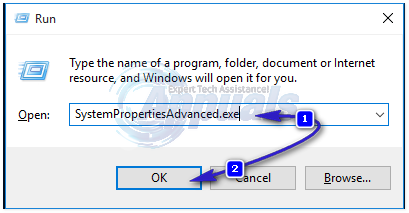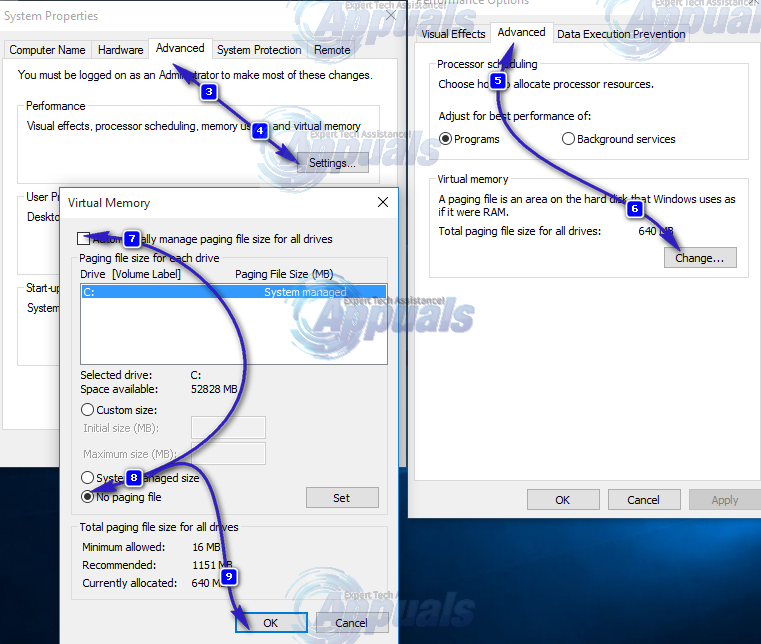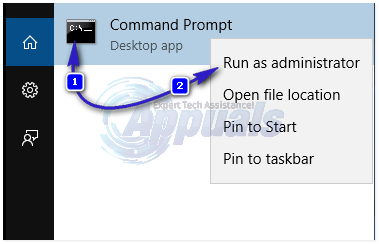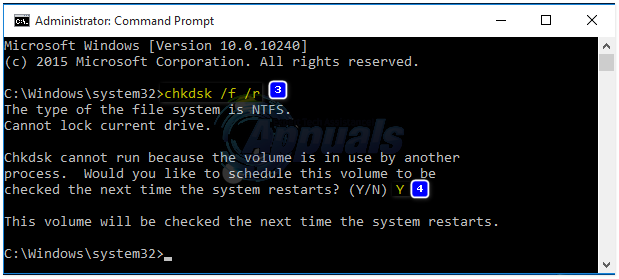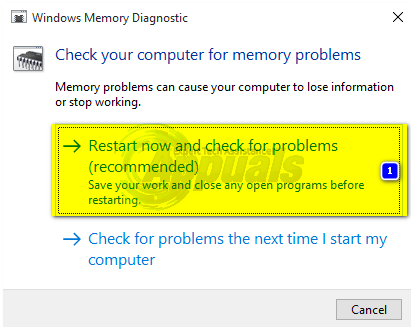Usually this error is attributed to a fault in your RAM’s connection to the motherboard or in the RAM itself, but there are other methods that can be followed before we open your system up. Also anti-virus programs are also known to cause this error. Make sure you try disabling before moving on with this guide and also follow our guide on this link https://appuals.com/blue-screen-of-death/ , and if all was in vain, then let’s start with Solution 1.
Solution 1: Re-create Page File
To speed up your system, Windows uses disk space on your hard disk. For this purpose it creates a page file which it refers to for speedy access to your frequently used programs. Disabling the page file can help get rid of the issue. To do this; Hold the Windows Key and Press R. In the run dialog, paste SystemPropertiesAdvanced.exe and press Enter to open it.
In the System Properties -> Click on Advanced tab then under Performance, click Settings. Then choose Advanced again from the new dialog that opens up. Clear the check box for Automatically manage paging file size for all drives. Select No paging file. Click Set and confirm any warning message. Click OK > OK > OK to close all windows. Restart your system.
After restarting, repeat the above steps to go back to Virtual Memory. Now select System managed size and click Set. Check the Automatically manage paging file size for all drives box at the top. Click OK > OK > OK to close all windows and restart your system. Any corrupt chunk in the page file must be deleted now. If you’re still getting the BSOD, move on to the next solution.
Solution 2: Run chkdsk
Chkdsk is a disk checking utility in Windows which is used to search and fix errors in file system. Click Start, type cmd, right click on cmd and choose Run As Administrator
Type chkdsk /f /r and press Enter. Let it run. If you get a message that “The drive is locked and if you would like to schedule a chkdsk on the next restart, type in Y for yes” then type Y and press Enter.
Restart your computer and let the chkdsk run. It will automatically detect and fix errors it finds. If you face the issue again, move on to Solution 3.
Solution 3: Run System Restore
Hold down Windows key and press R. In the run dialog type rstrui.exe and press Enter. Default choice will be Recommended Restore. However, what you need to look at is the date/time of the restore point when the system was working fine, this can be a month old or days old; to view more restore points; put a check on Show More Restore Points. If there are no restore points available (skip this solution) and create a restore point later when the issue is resolved. see here Click Next > Finish. Then follow the on-screen instruction to complete your system restore.
Solution 4: Update Windows
Microsoft also keeps releasing updates to counter these errors. Make sure your computer is up to date. For Windows 7 and 8: Press Windows key and type check for updates. Click Check for updates in the search results. Let the PC check for updates and make sure you have all of them installed. Most importantly the critical and important updates. For Windows 10: Press Windows Key + R. Type ms-settings:windowsupdate and press Enter. Now check for updates for your Windows and make sure you install all of them.
Solution 5: Driver Interference
Follow Solution 4: Check Driver Verifier in our guide here to make sure no driver is causing interference.
Solution 6: Run SFC scan
Follow our guide here to run a SFC scan. It is for Windows 10 but is applicable on Windows 7 and 8.
Solution 7: Windows Memory Diagnostics
RAM is the main component that is used for paging. A Faulty RAM can also trigger such errors. Hold down Windows key and press R. In the run dialog type mdsched.exe and press Enter. A dialog box will appear asking if you want to reboot and check RAM now or later. Select the option which suits you better.
When you reboot, your RAM’s checkup will start. If there are no errors, then your RAM is fine. If there are errors, try common approaches, to inspect RAM. If you have a laptop, then your RAM will be in a small compartment in the bottom of your laptop. In case of desktop, carefully open your CPU. RAMs will be fixed on your motherboard and will probably be more than one. If more than one, they will be placed parallel to each other. Remove both the sticks, and clean their golden contacts with a pencil eraser. Clean the slots with a spare toothbrush. To test each stick of RAM, if you have more than one of course, insert one stick of RAM at a time and see if you get the error. Similarly check if a slot itself is faulty by changing the slot with a known good RAM. If you don’t get the error with one RAM, then the other RAM is faulty for sure. If the results are same in all conditions, then the problem may lie within the motherboard itself. It would be best to send the laptop/desktop for hardware repair and diagnostic either to a service center or other repair stops.
FIX: Steps to fix iPhone 6 Error 4013FIX: Steps to fix a corrupted pst or ost outlook data fileFIX: Steps to Fix Error ERR_FILE_NOT_FOUNDFix: You need to fix your Microsoft Account for apps on your other devices to be…
